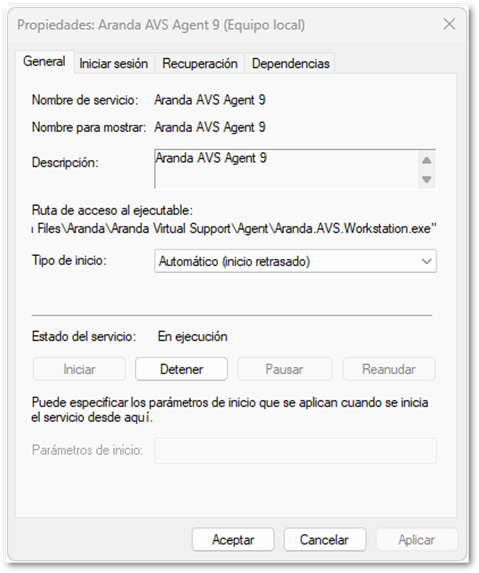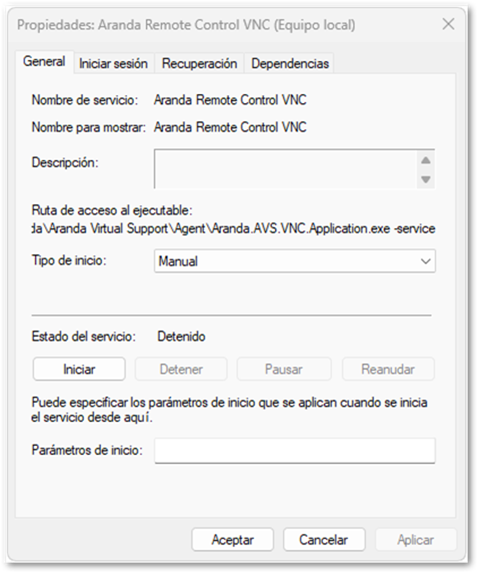Main Process
The main process of the agent is the one corresponding to the executable “Aranda.AVS.Workstation.exe”. When launched from the agent service it will look like this:

When launched as a user or executable, you will see in the User Name column, the user of the current Windows session:

This service is responsible for communicating with the main server, as well as managing the agent’s internal database and orchestrating the other processes.
No matter how the agent is launched, whether as a service or executable, there will only be a “Aranda.AVS.Workstation.exe” process
User Process
Regardless of whether the agent was launched as a service or executable, you will see a “Aranda.AVS.Workstation.UI.exe” process within each Windows session launched. The process will belong to each user, like this:

There will only be one process per Windows user session. This process is responsible for launching windows, icons, questions with a graphical user interface, as well as launching the processes of the AVS services that require running in the Windows user session.
AVS Service Processes
Remote control
The process in charge of allowing remote control is the one corresponding to the executable “Aranda.AVS.VNC.Application.exe”.
Depending on whether the agent is launched as an executable, you will see only one process for each Windows session started, as follows:

On the other hand, if the agent is launched as a service, you will see two processes of the same executable, one for the user of each Windows session and one for the service.

Main Service
If the agent has been installed with the service, you will see the following Windows service for the agent:

This service points to the executable “Aranda.AVS.Workstation.exe”
As can be seen, this service must be started automatically to allow functionalities without depending on a Windows session.
Additional Services for AVS Services
Remote control
If installed as a service, the following service must be available for remote control:

This service points to the executable “Aranda.AVS.VNC.Application.exe”
This service is launched by the service of the executable “Aranda.AVS.Workstation.exe”, so its startup must be manual.
Halting Processes
Regardless of the way the agent has been launched, if the agent is stopped correctly, it will in turn be responsible for stopping all the processes and services launched during its operation.
Internal communication between processes and services
For the aforementioned processes it is important to be able to send and receive messages. To do this, a GRPC communication is used in which each process listens on an internal port, without configuring firewall rules and without remote or external access to the computer; it is a local communication between processes.
The ports mentioned below are static. The agent will attempt to use those ports locally; however, in case they are busy, the agent will not work properly until the ports are available again.
Main Process
The main process of the executable “Aranda.AVS.Workstation.exe” tries to listen on TCP port 5050. On that port, it receives responses from interaction with the graphical interfaces of the user’s processes, “Aranda.AVS.Workstation.UI.exe”, as well as notifications from remote control services, user confirmation requests (if enabled), and notifications of agent updates.
This is the same regardless of whether it is released as a service or executable
File Transfer Process
The main process of the executable “Aranda.AVS.Transferfile.Service.Target.exe” tries to listen on TCP port 5029. Responses are received on that port from the interaction with file transfer between the workstation and the specialist agent.
Remote Control Process
The “Aranda.AVS.VNC.Application.exe” remote control process attempts to listen on TCP port 9087 when running within a user’s session on Windows locally. There it receives requests to start a remote control session. In this case, the agent attempts to use port 8081 for communication with the Turn Server; is the only port that must be allowed to go out to the Internet in order to communicate with the Local Turn Server.


